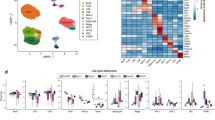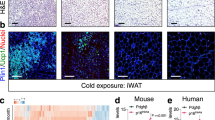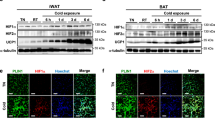Abstract
Background:
Recent studies suggest human neck brown adipose tissue (BAT) to consist of ‘brown adipocyte (BA)-like’ or beige adipocytes. However, little is known about their thermogenic function. Within the beige adipocyte transcriptome, fibroblast growth factor-21 (FGF21) is a gene whose protein product acts as an adipokine, regulating cold-induced thermogenesis in animals. Here, we explored (i) the adipogenic potential, thermogenic function and FGF21 secretory capacity of beige adipocytes derived from human neck fat and (ii) the role of FGF21 in modulating adipose bioenergetics.
Methods:
Progenitors isolated from human cervical fat were differentiated into adipocytes with either a BA-like or white adipocyte (WA) phenotype. FGF21 secretion was measured by enzyme-linked immuosorbent assay. Real-time PCR/western blotting was used to determine cellular mRNA/protein levels. Extracellular flux bioanalyzer was used to quantify adipocyte oxygen consumption and fatty acid oxidation. Adipocyte heat production was measured by infrared thermography.
Results:
Under hormonal manipulation, primary human neck pre-adipocytes differentiated into adipocytes with either BA-like or WA phenotypes, on gene/protein and functional levels. BA-like cells expressed beige but not classic BA markers. During BA differentiation, FGF21 gene expression and secretion were increased, and were augmented following norepinephrine exposure (a cold mimic in vitro). Differentiated WA expressed β-klotho, a critical co-factor mediating FGF21 action. Treatment of WA with FGF21-induced UCP1 expression and increased oxygen consumption, respiratory uncoupling, norepinephrine-mediated thermogenesis, fatty acid oxidation and heat production, thus recapitulating the association between cold-induced FGF21 secretion and cold-induced thermogenesis in vivo.
Conclusion:
Beige adipocytes are thermogenic in humans. FGF21 is a beige adipokine capable of promoting a brown fat-like thermogenic program in WAs.
Significance:
This study provides first evidence of inducible functional thermogenic beige adipogenesis in human neck fat. FGF21 holds promise as a cold-induced beige adipokine with metabolic benefits of therapeutic relevance through browning of white adipose tissue.
This is a preview of subscription content, access via your institution
Access options
Subscribe to this journal
Receive 12 print issues and online access
$259.00 per year
only $21.58 per issue
Buy this article
- Purchase on Springer Link
- Instant access to full article PDF
Prices may be subject to local taxes which are calculated during checkout






Similar content being viewed by others
References
Saito M, Okamatsu-Ogura Y, Matsushita M, Watanabe K, Yoneshiro T, Nio-Kobayashi J et al. High incidence of metabolically active brown adipose tissue in healthy adult humans: effects of cold exposure and adiposity. Diabetes 2009; 58: 1526–1531.
van Marken Lichtenbelt WD, Vanhommerig JW, Smulders NM, Drossaerts JM, Kemerink GJ, Bouvy ND et al. Cold-activated brown adipose tissue in healthy men. N Engl J Med 2009; 360: 1500–1508.
Virtanen KA, Lidell ME, Orava J, Heglind M, Westergren R, Niemi T et al. Functional brown adipose tissue in healthy adults. N Engl J Med 2009; 360: 1518–1525.
Cypess AM, Lehman S, Williams G, Tal I, Rodman D, Goldfine AB et al. Identification and importance of brown adipose tissue in adult humans. N Engl J Med 2009; 360: 1509–1517.
Lee P, Zhao JT, Swarbrick MM, Gracie G, Bova R, Greenfield JR et al. High prevalence of brown adipose tissue in adult humans. J Clin Endocrinol Metab 2011; 96: 2450–2455.
Lee P, Greenfield JR, Ho KK, Fulham MJ . A critical appraisal of the prevalence and metabolic significance of brown adipose tissue in adult humans. Am J Physiol Endocrinol Metab 2010; 299: E601–E606.
Lee P, Swarbrick MM, Ho KK . Brown adipose tissue in adult humans: a metabolic renaissance. Endocr Rev 2013; 34: 413–438.
Wu J, Bostrom P, Sparks LM, Ye L, Choi JH, Giang AH et al. Beige adipocytes are a distinct type of thermogenic fat cell in mouse and human. Cell 2012; 150: 366–376.
Petrovic N, Walden TB, Shabalina IG, Timmons JA, Cannon B, Nedergaard J . Chronic PPAR{gamma} activation of epididymally derived white adipocyte cultures reveals a population of thermogenically competent, UCP1-containing adipocytes molecularly distinct from classical brown adipocytes. J Biol Chem 2010; 285: 7153–7164.
Walden TB, Hansen IR, Timmons JA, Cannon B, Nedergaard J . Recruited vs nonrecruited molecular signatures of brown, ‘brite,’ and white adipose tissues. Am J Physiol Endocrinol Metab 2012; 302: E19–E31.
Sharp LZ, Shinoda K, Ohno H, Scheel DW, Tomoda E, Ruiz L et al. Human BAT possesses molecular signatures that resemble beige/brite cells. PLoS One 2012; 7: e49452.
Wu J, Cohen P, Spiegelman BM . Adaptive thermogenesis in adipocytes: is beige the new brown? Genes Dev 2013; 27: 234–250.
Kharitonenkov A, Shiyanova TL, Koester A, Ford AM, Micanovic R, Galbreath EJ et al. FGF-21 as a novel metabolic regulator. J Clin Invest 2005; 115: 1627–1635.
Chartoumpekis DV, Habeos IG, Ziros PG, Psyrogiannis AI, Kyriazopoulou VE, Papavassiliou AG . Brown adipose tissue responds to cold and adrenergic stimulation by induction of FGF21. Mol Med 2011; 17: 736–740.
Fisher FM, Kleiner S, Douris N, Fox EC, Mepani RJ, Verdeguer F et al. FGF21 regulates PGC-1alpha and browning of white adipose tissues in adaptive thermogenesis. Genes Dev 2012; 26: 271–281.
Hondares E, Iglesias R, Giralt A, Gonzalez FJ, Giralt M, Mampel T et al. Thermogenic activation induces FGF21 expression and release in brown adipose tissue. J Biol Chem 2011; 286: 12983–12990.
Ouellet V, Labbe SM, Blondin DP, Phoenix S, Guerin B, Haman F et al. Brown adipose tissue oxidative metabolism contributes to energy expenditure during acute cold exposure in humans. J Clin Invest 2012; 122: 545–552.
Lee P, Swarbrick MM, Zhao JT, Ho KK . Inducible brown adipogenesis of supraclavicular fat in adult humans. Endocrinology 2011; 152: 3597–3602.
Lee P, Greenfield JR, Ho KK . Hot fat in a cool man: infrared thermography and brown adipose tissue. Diabetes Obes Metab 2011; 13: 92–93.
Paulik MA, Buckholz RG, Lancaster ME, Dallas WS, Hull-Ryde EA, Weiel JE et al. Development of infrared imaging to measure thermogenesis in cell culture: thermogenic effects of uncoupling protein-2, troglitazone, and beta-adrenoceptor agonists. Pharm Res 1998; 15: 944–949.
Ding X, Boney-Montoya J, Owen BM, Bookout AL, Coate KC, Mangelsdorf DJ et al. betaKlotho is required for fibroblast growth factor 21 effects on growth and metabolism. Cell Metab 2012; 16: 387–393.
Ogawa Y, Kurosu H, Yamamoto M, Nandi A, Rosenblatt KP, Goetz R et al. BetaKlotho is required for metabolic activity of fibroblast growth factor 21. Proc Natl Acad Sci USA 2007; 104: 7432–7437.
Lee P, Brychta RJ, Linderman J, Smith S, Chen KY, Celi FS . Mild cold exposure modulates fibroblast growth factor 21 (FGF21) diurnal rhythm in humans: relationship between FGF21 levels, lipolysis, and cold-induced thermogenesis. J Clin Endocrinol Metab 2013; 98: E98–102.
Potthoff MJ, Kliewer SA, Mangelsdorf DJ . Endocrine fibroblast growth factors 15/19 and 21: from feast to famine. Genes Dev 2012; 26: 312–324.
Zingaretti MC, Crosta F, Vitali A, Guerrieri M, Frontini A, Cannon B et al. The presence of UCP1 demonstrates that metabolically active adipose tissue in the neck of adult humans truly represents brown adipose tissue. FASEB J 2009; 23: 3113–3120.
Jespersen NZ, Larsen TJ, Peijs L, Daugaard S, Homoe P, Loft A et al. A classical brown adipose tissue mRNA signature partly overlaps with brite in the supraclavicular region of adult humans. Cell Metabolism 2013; 17: 798–805.
Nedergaard J, Cannon B . UCP1 mRNA does not produce heat. Biochim Biophys Acta 2013; 1831: 943–949.
Cypess AM, White AP, Vernochet C, Schulz TJ, Xue R, Sass CA et al. Anatomical localization, gene expression profiling and functional characterization of adult human neck brown fat. Nat Med 2013; 19: 635–639.
Barbatelli G, Murano I, Madsen L, Hao Q, Jimenez M, Kristiansen K et al. The emergence of cold-induced brown adipocytes in mouse white fat depots is determined predominantly by white to brown adipocyte transdifferentiation. Am J Physiol Endocrinol Metab 2010; 298: E1244–E1253.
Lee YH, Petkova AP, Mottillo EP, Granneman JG . In vivo identification of bipotential adipocyte progenitors recruited by beta3-adrenoceptor activation and high-fat feeding. Cell Metab 2012; 15: 480–491.
Acknowledgements
We thank Dr Michael Sack and Dr Jie Liu from National Heart, Lung and Blood Institute, for advice on Seahorse bioanalyzer operations, and Dr Douglas Forrest, Laboratory of Endocrinology and Receptor Biology, National Institute of Diabetes and Digestive and Kidney Diseases, for helpful discussion and critical appraisal on the manuscript. Paul Lee is supported by the Australian NHMRC Early Career Fellowship, the RACP Foundation Diabetes Australia Fellowship, and the Bushell Travelling Fellowship. This study was supported by the Intramural Research Program of NIDDK: programs Z01-DK047057-02 and Z01-DK071044.
Author information
Authors and Affiliations
Corresponding author
Ethics declarations
Competing interests
The authors declare no conflict of interest.
Additional information
Supplementary Information accompanies this paper on International Journal of Obesity website
Supplementary information
Rights and permissions
About this article
Cite this article
Lee, P., Werner, C., Kebebew, E. et al. Functional thermogenic beige adipogenesis is inducible in human neck fat. Int J Obes 38, 170–176 (2014). https://doi.org/10.1038/ijo.2013.82
Received:
Revised:
Accepted:
Published:
Issue Date:
DOI: https://doi.org/10.1038/ijo.2013.82
Keywords
This article is cited by
-
Iron chelation increases beige fat differentiation and metabolic activity, preventing and treating obesity
Scientific Reports (2022)
-
Browning capabilities of human primary adipose-derived stromal cells compared to SGBS cells
Scientific Reports (2020)
-
PCB126 blocks the thermogenic beiging response of adipocytes
Environmental Science and Pollution Research (2020)
-
Bone Marrow Adipocyte Developmental Origin and Biology
Current Osteoporosis Reports (2018)
-
Myostatin signals through miR-34a to regulate Fndc5 expression and browning of white adipocytes
International Journal of Obesity (2017)



